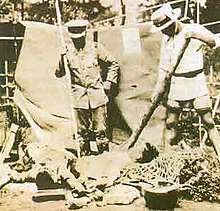Kantō Massacre
The Kantō Massacre was a mass murder which the Japanese military, police and vigilantes committed against the Korean residents of the Kantō region, Japan, immediately after the 1923 Great Kantō earthquake.[3] The massacre is also known as the Massacre of Koreans in 1923.
| Kanto Massacre | |
|---|---|
 Koreans in Japan about to be pierced by Japanese vigilantes with bamboo spears immediately after the 1923 Great Kantō earthquake. | |
| Location | Kantō region, Japan[1] |
| Date | September 1923 |
| Target | Koreans in Japan and socialists[1][2] |
Attack type | Mass murder |
| Weapons | Gun, Japanese sword and bamboo spear[1] |
| Deaths | at least 6,000[1][3][4] |
| Injured | unknown |
| Kantō Massacre | |||||||
| Japanese name | |||||||
|---|---|---|---|---|---|---|---|
| Kanji | 関東大虐殺 | ||||||
| Kyūjitai | 關東大虐殺 | ||||||
| Hiragana | かんとうだいぎゃくさつ | ||||||
| |||||||
| Korean name 1 | |||||||
| Hangul | 관동대학살 | ||||||
| Hanja | 關東大虐殺 | ||||||
| |||||||
| Korean name 2 | |||||||
| Hangul | 간토 대학살 | ||||||
| Hanja | 간토 大虐殺 | ||||||
| |||||||
The massacre occurred over a period of three weeks starting on September 1, 1923, the day on which a massive earthquake struck the Kantō region. During this period, soldiers of the Imperial Japanese Army, police and vigilantes murdered an estimated 6,000 ethnic Koreans and Japanese socialists.[1][3][4][5]
Background of the incident
The Kantō region of Tokyo was devastated by the Great Kantō Earthquake, and public and social order was in turmoil. In the midst of this, the Ministry of Home Affairs proclaimed martial law and instructed local police stations to do their best to maintain local security. At the time, the Ministry of Home Affairs told each police station, “There are a group of people who want to take advantage of disasters. Be careful because Koreans are planning terrorism and robbery by arson and bombs.” The report was printed in some newspapers without fact checking, and increasingly radical rumors were re-published in various newspapers such as The Asahi Shimbun and Yomiuri Shimbun. At the time the water supply was cut off due to the earthquake, and with most people living in wooden buildings, the rumors of arson caused intense hostility against ethnic Koreans and Chinese.
Japanese massacre of Koreans
As a result, Japanese citizens organized themselves into vigilante bands and carried out inquiries on people, and if the people who they inquired about were discovered to be Korean or Chinese, they brutally murdered them. The vigilantes were armed with bamboo spears, clubs, Japanese swords, and some of them were armed with guns. People who wore Korean or Chinese clothes were immediately killed, along with members of minority groups such as Ryukyuans whose spoken dialects were difficult for other Japanese people and foreigners to understand. Koreans, Chinese, and Ryukyuans wore Japanese clothing in order to hide their identities. They also tried to properly pronounce terms such as "十五円" and "五十銭" (15 yen and 50 sen), which consisted of long pronunciations, but their attempts to properly pronounce them failed. During that time, not only Koreans but also Chinese, Ryukyuans, and foreigners were all forced to call themselves Koreans. As a result, foreign journalists who came to Tokyo were mistaken for Koreans and killed due to differences in their pronunciations. Some Koreans sought safety in police stations in order to escape the slaughter, but in some areas vigilantes broke into police stations and pulled them out. The arrival of foreigners and other people in Tokyo meant death. The police reportedly documented the killings or passively responded to them. On the contrary, some members of criminal groups, such as the Yakuza, who accepted Koreans as members of the Korean government, hid Koreans. Along with the massacre of the Koreans, activists were simultaneously massacred, mainly leftists, who were registered in police files as socialists, anarchists, human rights activists, and anti-government activists.
Japanese security officials tolerate the massacre
The security authorities already knew that there were no "Korean riots" as rumored, but they had visited and encouraged vigilantes in the name of chaos and order recovery. However, when the vigilantes exceeded the limits and threatened the public power, they intervened, but only after many Koreans were slaughtered.
The vigilantes did not choose men and women of any age, and many of them were buried. When the massacre reached its peak, the rivers Sumidagawa and Arakawa which flowed through Tokyo were stained with blood. The Japanese government finally made public the occurrence of the massacre, but downplayed the number of victims. Some vigilantes were investigated, but it was only a formal measure, and there was no person or organization with judicial or moral responsibility for the massacre.
See also
- Great Kantō earthquake
- Nanking Massacre
- Gando Massacre
References
- "관동대학살" [Kanto Massacre]. Encyclopedia of Korean Culture (in Korean). Academy of Korean Studies. Retrieved March 3, 2018.
- "A play teaching the history of the Great Kanto Earthquake massacres to Japanese youth". The Hankyoreh. June 5, 2017. Retrieved March 3, 2018.
- "Yokohama recalls texts describing 1923 'massacre' of Koreans". The Japan Times. August 29, 2013. Retrieved March 3, 2018.
- "1923 Kanto Earthquake Massacre seen through American viewpoints". The Korea Times. August 31, 2016. Retrieved March 3, 2018.
- 関東大震災の朝鮮人虐殺事件 小池都知事の追悼文不送付など問題となっている背景へ迫る. KoreaWorldTimes (in Japanese). September 29, 2019. Retrieved June 28, 2020.